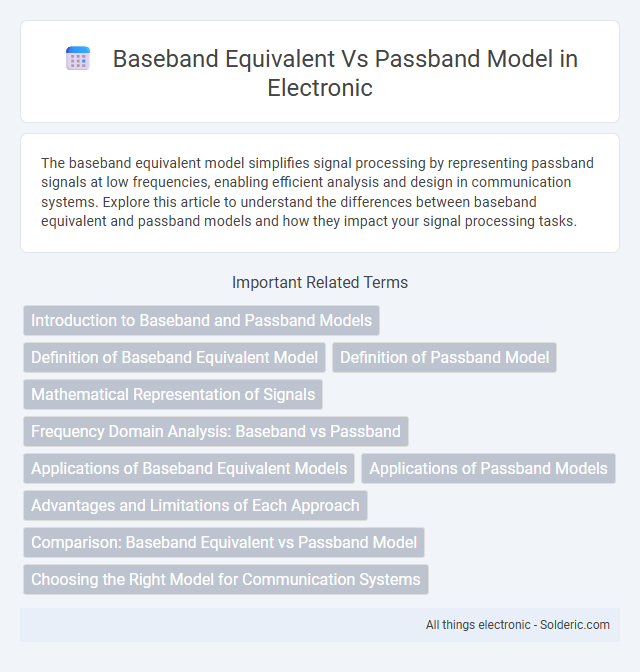The baseband equivalent model simplifies signal processing by representing passband signals at low frequencies, enabling efficient analysis and design in communication systems. Explore this article to understand the differences between baseband equivalent and passband models and how they impact your signal processing tasks.
Comparison Table
| Feature | Baseband Equivalent Model | Passband Model |
|---|---|---|
| Frequency Range | Low-frequency or centered at zero frequency | High-frequency, centered around carrier frequency |
| Signal Representation | Complex envelope (I/Q components) | Real-valued signal with carrier modulation |
| Complexity | Lower complexity, easier for analysis and processing | Higher complexity due to carrier and sidebands |
| Use Case | Digital communication system design and simulation | RF design, antenna, and modulation hardware analysis |
| Mathematical Model | Complex baseband equivalent equations | Trigonometric/passband real signals and carrier terms |
| Bandwidth Consideration | Equivalent bandwidth equals baseband bandwidth | Shifted bandwidth around carrier frequency |
| Filtering | Baseband filtering simpler and more efficient | Requires RF filtering tuned to carrier frequency |
Introduction to Baseband and Passband Models
Baseband and passband models are fundamental in communication system analysis, where baseband refers to signals with frequency components near zero Hz and passband involves modulated signals centered around a carrier frequency. The baseband equivalent model simplifies analysis by representing passband signals in a lower frequency domain, facilitating easier processing of filters and modulation schemes. Your understanding of these models is crucial for designing efficient digital communication systems and improving signal processing techniques.
Definition of Baseband Equivalent Model
The baseband equivalent model represents a passband signal by shifting its frequency spectrum to center around zero frequency, simplifying analysis and processing in communication systems. It captures essential signal characteristics using complex envelopes, allowing modulation and demodulation tasks to be treated as baseband operations rather than high-frequency passband signals. This model reduces computational complexity and facilitates the design of digital communication algorithms by focusing on baseband representations instead of full passband waveforms.
Definition of Passband Model
The passband model represents a communication signal at its actual carrier frequency, incorporating both amplitude and phase variations within a high-frequency band. It captures real-world electromagnetic wave propagation characteristics, making it essential for analyzing signal behavior in wireless channels and RF systems. This model contrasts with the baseband equivalent, which translates the signal to a low-frequency band for simplified processing and analysis.
Mathematical Representation of Signals
The baseband equivalent model represents signals using complex envelopes that simplify analysis by shifting the frequency spectrum to zero baseband, expressed as \( s(t) = I(t) + jQ(t) \) where \( I(t) \) and \( Q(t) \) are in-phase and quadrature components. The passband model represents signals as real-valued functions modulated onto a carrier frequency, defined mathematically as \( s(t) = A(t) \cos(2\pi f_c t + \phi(t)) \), where \( A(t) \) and \( \phi(t) \) denote amplitude and phase variations. Mathematical transformation from passband to baseband involves demodulation to obtain complex envelopes, facilitating simpler modulation schemes and channel analyses in communication systems.
Frequency Domain Analysis: Baseband vs Passband
Frequency domain analysis in baseband equivalent models simplifies signals by shifting the spectrum to center around zero frequency, enabling easier manipulation and filtering. Passband models represent signals at their original carrier frequencies, preserving the spectral components' position but requiring more complex processing. Your choice between baseband and passband depends on the application's complexity and computational resources.
Applications of Baseband Equivalent Models
Baseband equivalent models are widely used in digital communication systems for signal processing tasks like modulation, demodulation, and channel estimation. Your design benefits from simplified analysis of bandwidth and noise effects, enabling efficient implementation of filtering and error correction algorithms. These models are essential in software-defined radios and wireless communication systems to accurately simulate and optimize complex signals at baseband frequencies.
Applications of Passband Models
Passband models are essential in wireless communication systems for accurately representing RF signals and enabling precise modulation and demodulation processes. They are widely applied in the design of filters, amplifiers, and mixers operating at carrier frequencies to ensure signal integrity and reduce distortion. Passband modeling is crucial in analyzing spectral characteristics and optimizing bandwidth allocation in complex communication protocols like OFDM and CDMA.
Advantages and Limitations of Each Approach
The baseband equivalent model simplifies analysis and design by representing signals at low frequencies, reducing computational complexity and enabling efficient simulation of digital communication systems. However, it may not accurately capture high-frequency phenomena such as RF impairments and antenna effects, limiting its applicability in hardware-level design. The passband model provides a more precise representation of real-world signals at carrier frequencies, essential for detailed analysis of modulation, filtering, and propagation effects, but it demands higher computational resources and complexity in system simulations.
Comparison: Baseband Equivalent vs Passband Model
The baseband equivalent model represents signals and systems using complex low-frequency components, simplifying analysis by focusing on in-phase (I) and quadrature (Q) components, while the passband model deals with real high-frequency signals centered around a carrier frequency. Baseband models enable efficient simulation and signal processing tasks such as modulation and demodulation, reducing computational complexity compared to the passband approach. Passband models are essential for accurately capturing real-world RF characteristics and propagation effects, making them critical for hardware implementation and system performance evaluation at the carrier frequency.
Choosing the Right Model for Communication Systems
Choosing the right model for communication systems depends on the application and complexity; the baseband equivalent model simplifies analysis by representing signals centered around zero frequency, making it ideal for digital communications and system design. Passband models, which represent signals modulated at a high carrier frequency, are essential for accurately analyzing radio frequency (RF) behavior and physical channel effects. You should select the baseband model for efficient simulation and algorithm development, while the passband model suits scenarios demanding detailed spectral and hardware-level analysis.
baseband equivalent vs passband model Infographic

 solderic.com
solderic.com